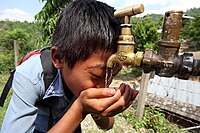
Photo from wikipedia
One of the most important agricultural areas in Iran is Golestan Province. In this study, the suitability of groundwater for irrigation purposes was assessed. To determine hydro-geochemical classification of the… Click to show full abstract
One of the most important agricultural areas in Iran is Golestan Province. In this study, the suitability of groundwater for irrigation purposes was assessed. To determine hydro-geochemical classification of the station and assessment of spatial modeling of the study area, 12 groundwater stations were selected and an average of the last 5 years of sampling (2011–2015) has been considered. Suitability of groundwater for irrigation was assessed based on Sodium Adsorption Ratio (SAR), Residual Sodium Carbonate (RSC), Na%, Permeability Index (PI), Magnesium Adsorption Ratio (MAR), Kelley’s Ratio (KR), Corrosion Ratio (CR), Residual Sodium Carbonate (RSC), Potential Soil Salinity (PSS), Chloro-Alkaline Indices (CAI), Meteoric genesis (Met. gen) and Wilcox classification. The abundance of major ions followed a HCO3 > SO4 > Na > Ca > Mg > Cl > K trend. CAI results indicate reverse cation exchange for this area, and Wilcox classification indicates that only Kalou, Kafshgari, and Kia stations are appropriate for irrigation. The spatial distribution of groundwater quality demonstrates a decreasing trend from SE to NW based on CAI, Cl, CR, EC, TSS, and TDS and shows reverse trends for KR, MAR, Met. gen, Mg/Ca, Na%, pH, PI, and RSC. In addition, the results of hydro-geochemical classification of irrigation parameters have categorized the irrigation water of this area into three different classes. Based on EC, MAR, Mg/Ca, Cl and CR, this area is suitable, but based on PSS, KR, and TH, all stations are unsuitable and according to SAR, TDS, Na% and PI, this area’s groundwater is moderate.
Journal Title: Paddy and Water Environment
Year Published: 2017
Link to full text (if available)
Share on Social Media: Sign Up to like & get
recommendations!